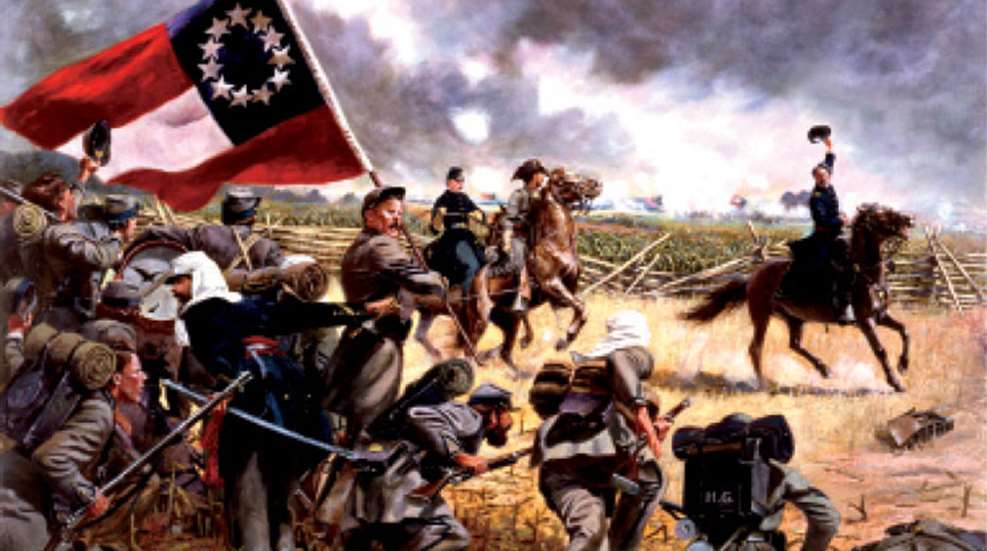
By Joseph G. Bilby
Top image: Armed with .69-cal. U.S. Model 1842 Muskets on July 21, 1861, the 4th Alabama surges forward in Don Troiani’s “Up Alabamians.”
As two amateur armies groped to find and fight each other across the Northern Virginia countryside in the stifling heat of July 1861, they did so with a variety of arms, the vast majority of them obsolescent—if not altogether obsolete.
At first glance, it would seem that since the United States had adopted a new family of military small arms a half-dozen years before, Union and Confederate armies would have carried 1855 models. This was not the case, however. Production at the National Armories at Harper’s Ferry, Va., and Springfield, Mass., had been slow. While the small regular army was rearmed with the new-pattern guns by 1861, few had been issued to state militias, and others were stored in regional federal arsenals.

U.S. Model 1808 Musket converted from flintlock to percussion
The Model 1855s, in .58 cal., included a rifle-musket with a barrel length similar to that of the older smoothbore musket and a shorter, heavier-barreled rifle. Both were designed to fire a hollow-based conical projectile, named after its inventor, French army Maj. Claude Minié. The American “Minie ball,” however, was actually Harper’s Ferry Armory superintendent James Burton’s improvement on Minié’s design. Burton discarded the base plug and deepened the bullet’s base cavity to achieve the same result. On firing, the under-bore-size conical projectile expanded into progressive-depth (deeper at breech than muzzle) shallow rifling, imparting spin and hence improving accuracy. Lubricated with a beeswax-tallow mixture to reduce fouling from subsequent shots, the bullet was encased, along with a 60-gr. charge of musket powder, in a paper cartridge.
To load his Model 1855, a soldier bit off the end of the cartridge, poured the powder down the muzzle of the gun, discarded the paper, inserted the bullet and rammed it home. He then brought the hammer to the half-cock position, affixed a copper percussion cap lined with an explosive compound to the nipple or “cone” at the breech, thumbed the hammer to full cock, aimed and fired. The 1855s were also equipped with the Maynard tape primer device—a ratchet that advanced a roll of paper-encased priming pellets, similar to a 1950s-era child’s cap pistol, each time the hammer was cocked. Working properly, the Maynard system increased a shooter’s rate of fire by eliminating the need to manually place a cap on the nipple. The system did not live up to expectations in field use, however, and standard caps were used more often than not. It was not employed in subsequent models.
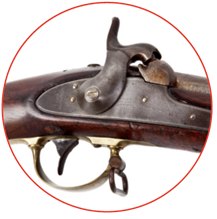

U.S. Model 1841 “Mississippi” Rifle
In the spring of 1861, the most common small arms in militia hands or stored in federal and state arsenals, North and South, were .69-cal. smoothbore muskets. Some of these were late Model 1842 muskets in percussion ignition. More, however, were the 1816 or even earlier pattern guns, originally manufactured as flintlocks. Many had been modernized by conversion to percussion during the 1850s, but a substantial number remained in their original configuration.
Percussion or flintlock, the smoothbores fired the same ammunition: a paper cartridge containing a 110-gr. charge of musket powder and a .65-cal. round ball or, more commonly, the round ball and three approximately .31-cal. buckshot, commonly referred to as “buck and ball.” A soldier loaded his smoothbore by biting off the end of a paper cartridge, depositing a small priming charge in the pan if his gun was a flintlock, and then inserting the whole cartridge, open end first, into the muzzle and ramming it down. The paper prevented the undersized ball and buckshot from rolling out, reducing powder gas blow-by on firing and somewhat stabilizing the projectiles in the bore to provide better accuracy.
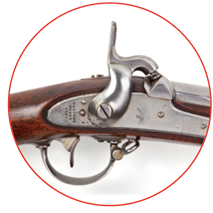

U.S. Model 1842 Musket
Some late-model flintlock arms were not only converted to percussion ignition but were, along with some Model 1842s, rifled and mounted with long-range sights to fire a .69-cal. conical Minié/Burton bullet. Some conversions were also fitted with the Maynard priming device. Although the words have been used interchangeably since the 1850s, these guns are properly called “rifled muskets” to differentiate them from the purpose-built “rifle-musket.”
A third type of small arm was the rifle. The Model 1855 rifle was intended to fire the same projectile as the rifle-musket, and was simply a shorter, heavier-barreled version. For many years, however, the U.S. Army had been issuing .54-cal. rifles with deep-cut rifling designed to fire a round ball encased in a greased cloth or leather patch. These rifles were intended for special-unit use, and many were stored in federal and state arsenals. While some were older flintlocks converted to percussion, the most popular rifle was the good-looking, brass-mounted Model 1841, or “Mississippi,” which had gained fame in the hands of Col. Jefferson Davis’ regiment of Mississippi volunteers at the Mexican War battle of Buena Vista. Like its predecessors, the 1841 was initially produced in .54 caliber with fixed front and rear sights and no provision for a bayonet.
By 1861, many Model 1841s had been modified with barrel side lugs to attach sword bayonets, or had their muzzles turned down to take Model 1842 musket socket bayonets. Some were re-bored to .58 caliber with shallow groove progressive rifling and fitted with long range-sights, but those remaining in .54 retained the older-style rifling. Conical hollow-base bullets were issued in .54 caliber, but often gave less-than-satisfactory results because of the Minié ball’s failure to expand enough to fill the old-style deeper grooves, allowing gas blow-by. In the mid-1850s, regular army troops in the Northwest reported that rifled .69-cal. Model 1842 muskets were more accurate than the .54-cal. Model 1841 fired with conical projectiles. No matter—the reputation the Model 1841 gained in the Mexican War made it an iconic and desirable firearm, especially in the eyes of Southerners.
The Union had an extensive industrial base that would produce a vast number of arms in subsequent years, and both sides would import many thousands of arms from Europe, but in the spring of 1861 the belligerents only had to make do with what they had on hand. In the case of the Confederacy, that included arms in state arsenals and those appropriated from federal arsenals in the South. The vast majority of these guns were smoothbore muskets. The seizure of the Mount Vernon Arsenal in Alabama resulted in the capture of 22,000 small arms, 2,000 of them Model 1841 rifles and the remainder smoothbores, including converted flintlocks and Model 1842s. Of more than 10,000 arms confiscated by Arkansas militiamen from the federal arsenal at Little Rock in February 1861, more than half were flintlock smoothbore muskets, with the rest a grab-bag of varied out-of-date arms along with a handful Model 1841 rifles. Subsequent imports would not make the situation simpler.
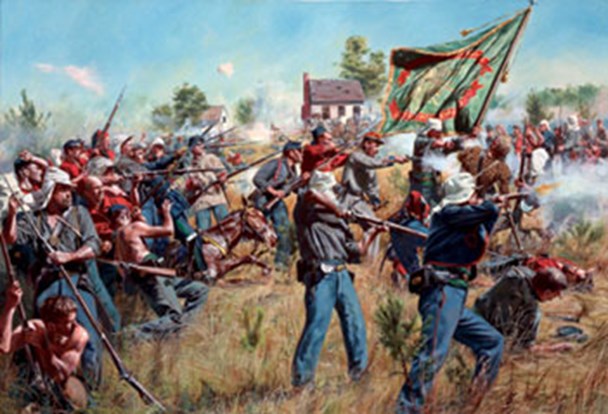
The 11th New York—the Fire Zouaves—as depicted in Don Troiani’s “New York’s Bravest” were armed with modern Model 1855 rifle-muskets, but the 69th New York had a mixture of .69-cal. rifles and smoothbores.
On May 7, 1861, Confederate Ordnance Chief Maj. Josiah Gorgas reported that the Confederacy had, in addition to supplies in state hands, 159,010 small arms at its disposal at six seized federal arsenals. The largest stock, and representative of the whole, was at the Baton Rouge arsenal, which held a hodge-podge of 47,372 guns including some .69-cal. guns rifled for conical projectiles and a few .58-cal. rifle-muskets, as well as a large number of percussion and flintlock smoothbores, Model 1841 rifles, a few Colt revolving rifles and revolvers, breechloading Hall and other assorted carbines and single-shot percussion pistols. Gorgas also had 3,200,000 cartridges of various calibers and 168,000 lbs. of powder in his inventory. Although the highly efficient major got arms into the hands of most Confederate soldiers in fairly short order, many of them were undeniably obsolete, and one observer recalled that Confederate forces in Virginia in the summer of 1861 were equipped with “ragtag equipment for a tatterdemalion army.”
Someone once wrote that “the Confederacy died of states’ rights.” While an exaggeration, like many old nostrums, there was a kernel of truth in the assertion. Governors such as Georgia’s Joseph Brown often considered their states’ interests more important than those of their newly declared country, particularly in the case of firearm allocations. On May 18, 1861, Brown’s adjutant general ordered that no state-issued firearms could leave Georgia, and that officers taking arms, as well as men, into Confederate service would be held personally financially liable. In compliance, three companies of the 8th Georgia Infantry reluctantly handed in their prized Model 1841 rifles. One captain secured a resupply of 1841s for his company from the Confederate ordnance department, but the others reached Richmond unarmed.
Yet another company of the 8th, the “Oglethorpe Light Infantry,” an elite unit from Savannah, eluded Brown’s edict and arrived in Virginia with state-of-the-art .58-cal. Model 1855 rifles. The regiment’s other companies ended up shouldering .69-cal. smoothbore percussion conversions. Other Southern units, deemed elite by their own definition, managed to acquire Model 1841 rifles, including Roberdeau Wheat’s “Special Battalion” of roughneck Louisiana Zouaves, also known as the “Louisiana Tigers.” Interestingly, although Governor Brown is often singled out as a prime example of an uncooperative Southern state executive, the governor of Maine ordered that the few hundred Model 1855 rifle-muskets issued to militia units in Maine be collected and stored in the state arsenal at the outbreak of war, and Maine’s men went to Washington armed with smoothbores.
In January 1861, the U.S. Ordnance Dept. reported a total of 576,800 arms in service or storage, exclusive of state stores, of which 35,335 were pattern 1855 .58-cal. arms. Deducting the arms seized by Southern states still left a significant number accessible to the Union army. In the event, however, federal militia and volunteer units were hardly better armed than their Confederate counterparts, as the vast majority of guns in storage were smoothbore muskets.
The experience of the New Jersey militia brigade is perhaps typical of early Union volunteers. The state had fewer than 2,000 men in its active militia units in 1860. While a few companies were armed with Model 1841 .54-cal. rifles, none had access to the latest pattern arms. The militia brigade the state hastily raised to meet President Lincoln’s call for troops to defend Washington mustered 3,075 men, who thought they would be issued “first class arms direct from Springfield Arsenal.” Much to their dismay, however, they were issued .69-cal. smoothbore percussion conversions from the state arsenal at Trenton. One regiment tried, and failed, to return their arms, which they considered “very defective.” More importantly, there was virtually no ammunition available for the muskets on hand. An officer had to travel to New York City to buy 3,500 ball cartridges and 10,000 percussion caps at a gun store on Broadway, arriving at Trenton just as the brigade left for Washington on May 3.
The Jerseyans arrived in the capitol on May 6 and on May 11 marched to the Washington arsenal to trade their state-issue arms for federal-issue arms. Anticipating rifle-muskets, they were sorely disappointed when they swapped their percussion-conversion smoothbores for federal arms of the same type. They actually thought themselves worse off, since the guns they turned in had browned barrels and the new ones were polished steel, adding to their military maintenance chores.
New York had a mere 1,500 firearms of all sorts in storage in 1861 and at the outset of the war made an emergency request to Springfield Armory. By the end of April the state received 23,000 muskets, all of them Model 1842 smoothbores. Virtually all of the New York units that shipped out to Washington in the first months of the war were armed with those 1842s; one notable exception was the 11th New York Infantry, also known as Ellsworth’s Fire Zouaves, after their colonel, Elmer Ellsworth. Ellsworth had initiated the Zouave craze by touring the country with his Chicago Zouave Cadets before the war and had worked in Abraham Lincoln’s law office, which probably accounts for the fact that the 11th was issued Model 1855 rifle-muskets.
Military leaders North and South concluded that the best way to employ the limited number of rifled arms available to the state militia and new volunteer regiments was to ration them, as had occurred by default with the Georgians. Capt. Thomas F. Meagher’s Zouave company of the Irish-American 69th New York State Militia were issued .69-cal. rifled muskets, while the rest of the regiment shouldered smoothbores. The 1st Connecticut Militia had eight companies armed with smoothbore muskets and two “flank companies,” which, like the Irish Zouaves, were intended for individual aimed-fire skirmishing in front of the battle line. The Nutmeg skirmishers were issued scarce Model 1855 rifle-muskets and even scarcer Sharps breechloaders. The 2nd New Hampshire Infantry mustered nine companies armed with smoothbores, deemed excellent for “close work,” while one company was armed with Sharps breechloaders privately purchased by the citizens of Concord.
Other federal units, like the Oglethorpe Guard and the 11th New York, apparently used status and connections to well-arm themselves. The 1st Rhode Island, formed from the state’s elite militia companies, is a prime example. Seven companies of the 1st were armed with 1855 rifle-muskets and three with 1855 rifles. Most enlisted men carried privately purchased revolvers, and each company fielded seven men armed with breech-loading Burnside carbines. Prior to Bull Run, the soldiers carrying Burnsides were formed into a “Carbineer” company.
A number of soldiers other than the Rhode Islanders brought personal handguns to war, mostly officers, but including some enlisted men—sometimes with unfortunate results. One Jerseyman, apparently inebriated, shot another accidentally while “skylarking” with his sixgun on the way to Washington. In the event, handguns played no significant part in the combat at Manassas. In the future they would prove most effective in irregular mounted warfare.
“Close work” was about all one could expect with any arms the armies carried at Bull Run, as the soldiers who fought there had little or no instruction in using them beyond how to load and fire them. The limited-range smoothbore, with which the vast majority were armed, was not considered a long-range firearm, but effective use of even the small number of rifles and rifle-muskets in the ranks at ranges beyond point-blank depended on a shooter’s ability to correctly estimate distance and adjust his sights to compensate for the Minié ball’s arc-like trajectory. Training in drill had been minimal—and in marksmanship non-existent—prior to the battle, so, in the end, armament was largely moot. No matter the weapon, most small arms firing during the Battle of Bull Run was at ranges under 200 or even 100 yds.
Committing a historically common error, i.e., believing the course of a previous war predicts that of current hostilities, both sides looked to the Mexican-American conflict of 1846-48. A few big battles (perhaps even one) with relatively few casualties should settle matters, or so they thought. In the summer of 1861, pressure mounted on Gen. Irwin McDowell, commanding the Union forces around Washington, to initiate offensive operations against Gen. P.G.T. Beauregard’s Confederate army located near Manassas Junction, Va., before the 90-day enlistments of many of his militia troops expired.
On July 16 McDowell led 35,000 men south toward Beauregard’s 22,000-man force, hoping Gen. Robert Patterson’s Pennsylvania militiamen would hold Gen. Joseph E. Johnston’s 12,000 Confederates in the Shenandoah Valley. McDowell arrived at Centreville on July 18 and found Beauregard’s army deployed on high ground across a stream known as Bull Run. Both generals decided to take the offensive, attempting to outflank each other. Unfortunately for the Union, as it turned out, McDowell, who based his campaign from the start on a “turning movement” (a reprise of Gen. Winfield Scott’s Mexican War operations), moved his army first, on the morning of July 21. Beauregard’s failure to mount an offensive actually worked to his benefit, since untrained troops typically fight better in defense. Even worse for the Yankees, Johnston had slipped away from Patterson and reinforced Beauregard. The Union attack, initially successful, became unhinged as the enemy defense stiffened. General Thomas J. Jackson stood “like a stone wall,” and the federals began to come apart. McDowell’s men panicked and the subsequent rout sent them rolling back to Washington in a tide that carried along with it frightened civilians, who had come out to watch the fight for entertainment. Luckily for the Unionists, the Confederates were as disorganized by victory as the federals by defeat, and there was no effective pursuit. By later war standards, casualties were light, with 460 Union soldiers killed, 1,124 wounded and 1,312 missing, most of the latter captured in the wild retreat. Confederate losses were 387 killed, 1,582 wounded and 13 missing.
There was a lot of shooting at Bull Run, most of it at close range, but perhaps not as many rounds were expended as one might expect. Interestingly, the pre-war U.S. Army Ordnance manual prescribed that a supply of 200 cartridges per man be on hand as an army approached combat, with 40 to 60 carried by each soldier and the rest in reserve. At Bull Run, Maj. Gorgas was able to provide only “fifty to seventy rounds” total per man. In his after-action report, however, the major revealed that the Confederates had expended only “from about 19 to 26 rounds per man,” which would include dropped or discarded cartridges as well as those fired, and concluded that “there need be no scarcity with 60 rounds per man, or even fifty.” The Union army’s average expenditure was probably similar. Only about 18,000 men on each side saw action at Bull Run, however, and that may have skewed the ratio. Still, Gorgas would claim after the war, no Confederate army ever lost a battle due to lack of ammunition. He was right.
Effectiveness Of Buck And Ball
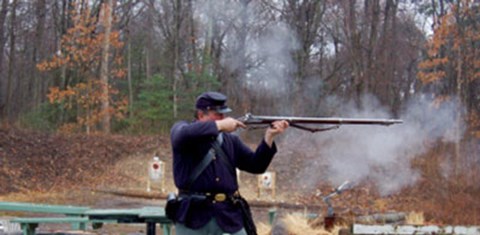
The most common small arm on the field at Bull Run was the smoothbore musket, and the most common cartridge used in the smoothbore was the “buck and ball” round. In order to get an idea of the effectiveness of period ammunition, I had reproduction buck and ball ammunition with a 0.648" round ball (approximating the original specification of .65 caliber) and three .31-cal. buckshot, crafted by New Jersey Civil War re-enactor Art Green, who makes replica cartridges virtually identical to original ammunition. There were numerous complaints during the war regarding the poor quality of the powder and in consistency of charge weights in issued cartridges; so, since we were using modern powder of known quality, Green loaded 80 grs. of GOEX FFG for consistency.
Two experienced Civil War firearm shooters, Steve Garratano and Kevin Marshall, fired the guns used in the experiment. One was a Pedersoli reproduction Model 1842 musket, and the other was an original Model 1842. The original gun sported a “shooting” barrel made up a few years ago by Bob Hoyt, who lengthened and lined an original cut-down tube. Thus the interiors of both barrels were as clean and smooth as they would have been in 1861.
We shot at standard silhouette targets set up at 50 and 100 yds., with the new, smaller Birchwood Casey “Dirty Bird” splattering silhouette targets stapled inside the larger ones to make it easier to identify hits in what would have been vital areas. The targets were set at intervals about 2 ft. apart. All shooting was offhand. At 50 yds., 10 rounds loaded from the cartridge box and fired at three silhouettes resulted in 12 hits, three of them from balls, the remainder from buckshot. All rounds appeared to impact in the backstop berm, and a chronograph reading revealed velocity to be 1121 f.p.s.
At 100 yds., there were five additional hits in the targets, all from buckshot, many of which appear to have hit the ground at around 80 yds. and then ricocheted up to strike at about waist level. This was in sandy soil, so the ricochet factor would be compounded in rocky terrain. The 0.648" balls noticeably impacted the backstop. It appears that men, even in close formation, would be relatively safe from buckshot beyond 100 yds., but that the larger ball projectile, while not “accurate” in the modern sense, would continue to be effective on large groups of soldiers beyond that range. —Joseph G. Bilby




































